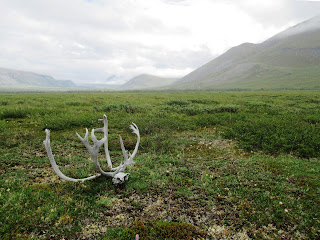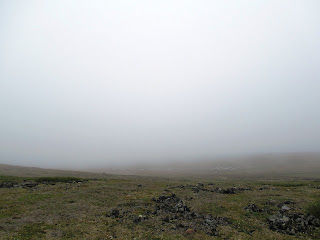"The storm was swinging eastward...[T]he sun was shining brilliantly on countless lofty peaks without name and beyond the scope of human knowledge. All around [me] were gorges, thousands of feet deep, great snowbanks, bright green valleys, gaily colored rocks. All was peace and strength and immensity and coordination and freedom" — Bob Marshall, Alaska Wilderness
Water, rock, snow, moss, sedge, sky, fog, and my feet—that was my world, for 11 days. Seventy-odd miles through the Brooks Range along what, retrospectively, was a poorly-chosen route from the Dalton Highway to Anaktuvuk Pass. A million dangers and me trying to navigate them, alone.
Terrifying. Affirming. Elemental.
Water, rock, snow, moss, sedge, sky, fog, and my feet—that was my world, for 11 days. Seventy-odd miles through the Brooks Range along what, retrospectively, was a poorly-chosen route from the Dalton Highway to Anaktuvuk Pass. A million dangers and me trying to navigate them, alone.
Terrifying. Affirming. Elemental.
No, there was more than that. There were flowers—everywhere
I stepped, colorful, delicate little Arctic blooms. Fuchsia-colored frigid shooting-stars
rising up and arcing bashfully back down. Creamy bell-heather ringing out
across entire hillsides. Tall, pink-stemmed wintergreen boasting a dozen
greenish-white blossoms. Blue-purple narrow-leaved gentians barely beginning to
bud. Bright yellow Arctic poppies eagerly following the summer sun as it
circumambulated the sky. Dozens of species, hundreds of thousands of individual
plants. How many did I crush underfoot, just trying to keep trudging, to make it
across the ridges and through the ravines?
And there were animals. Every now and then, I registered the
anxious chirping of ground squirrels or anxious cheeping of, um, black-bellied
plovers? (I’m not very good at bird identification, especially when I’m tired
and hungry and want nothing more than to not be where I am.) Snipes sniped from
the marshes. Ravens laughed from the ridges. A couple of moose loped languidly
through the same stretch of sedges and brush that had taken me a full day to
fight through. Surely, bears and wolves were watching, waiting to pounce;
they’d left their pawprints everywhere, signs telling interlopers to be wary, be aware.
And of course there were rocks (usually my favorite part of a place, other than the clouds). Thick ledges of limestone, glinting scarps of schist, great cobbles of conglomerate, stacked on top of one another at precarious angles with dubious stability. The mountains only pretended to be solid, intact, timeless; erosion was the true master here. I lost count of the number of fresh-looking talus-fields I had to negotiate, much less the frequency with which boulders shifted underfoot. Riverbanks gave way. Rockfalls reverberated through rain and mist. One afternoon, without warning--crash...crashcrashcrash whoosh; a chunk of mountainside gave way, just across the Itkillik River from me. (I wasn't comfortable with that distance. Elsewhere on the Itkillik, at some point within the last decade or so, judging from the vegetative regrowth, half of a peak rising 3,000 feet directly up had slid off and crashed all the way down to the other side of the valley, damming the river and leaving great piles of debris. The scar is so enormous that it’s visible from satellite imagery on Google maps.)
Other than that, there were bogs. Meadows. Hidden pools and
rivulets. Perilously steep mountain “passes”. Waist-deep rivers considered mere
side drainages, not even worth a name on the maps. Add to that the wind, the
rain, the ice and snow. The mosquitoes.
Good god, the mosquitoes.
Good god, the mosquitoes.
That’s what I went for, no? To feel tired and cold and
hungry and afraid. To feel grateful for little miracles—a break in
the clouds or a stretch of solid ground. To soak in the silence. (There was
never any silence. Water, always running water, usually wind, and those rockfalls.) To live consciously, putting effort into every step. (Just getting
water was an ordeal: paying attention to when the bottle was running low,
keeping an eye out for an appropriate stream—deep enough, not too deep; clear,
not silty or sandy; with enough of an accessible bank; preferably, little
vegetation around and thus lower concern for bears or moose—taking off the
pack, getting out the pump, assembling the pump, being careful not to let
the clean hose get in the water, pumping, being careful not to tip the
water bottle, careful again with the clean hose while disassembling the
pump, repacking, and—the hardest part of the whole ordeal—convincing myself to heft that awful pack back on again and continuing.)
To be self-sufficient,
comfortable with silence and self and that huge, wild world.
Traveling alone, I had to be self-sufficient. If I wanted a
sip of water, I couldn’t just ask someone to please grab my water bottle; I had
to stop, take off the pack. If my stove was slightly temperamental, I couldn’t
just borrow someone else’s. If I wasn’t sure where I was, I couldn’t pore over
the maps with another set of eyes. If I wasn’t sure whether a river was safe to
cross, I couldn’t talk it over with someone else. I had to pace back and forth
along the bank for a while, plunge in, sometimes retreat, then plunge back in
again, knowing that I had to get across, even if the current was stronger than me.
(Swollen with rain and turbid with silt, the rivers were so
very, very much stronger than me. But I had to cross
them. Alone.)
On the plus side, no one else was around to watch me crawl
up onto a bank, post-river-crossing, and lie on the mud and rocks, sobbing with
terror and gratitude. No one saw me swing my trekking poles wildly through the
air, swatting and swearing at mosquitoes. No one could tell me that I was an
idiot for crossing the dangerously steep snowbank, or laugh when I fell in the bog. Or
laugh even harder when I fell in the same bog again. No one made me get out of my cozy tent,
pack up, and start hiking when it was cold and rainy out. Instead, I was
responsible for making myself do that.
The best part was getting to stop whenever and wherever I
wanted, then getting to stay put for as long as I wanted (or until I finished off my
daily ration of m&ms). In general, I hit a routine of hiking for 40
minutes and resting for 20, but I also had some luxuriously long tundra naps, nestled into a warm carpet of lichens,
mosses, and tiny shrubs. It was
nearly as blissful to snuggle into my sleeping bag at night, feeling warm and
safe against the rain and hail and wind outside. One long hazy evening--the only cloud-free stretch of the whole trip--I
chose not to put the rainfly on my tent so that I could wake periodically to see the deep pink orb of the sun circumambulating the wide headwaters of the Anaktuvuk River, painting snowcapped mountains in fluorescent hues.
Bob Marshall’s Alaska Wilderness was all celebration, all
beauty and exhilaration. Euphoria, not fear of rockslides, not a
stream-crossing every hour; no mention of him waking at 2 a.m. in the middle of
a cold downpour with an urgently full bladder. Sure, some tussocks; sure,
nearly getting swept down a few rivers. But bears? Shoot ‘em. Mountains? Climb
‘em. Sixty-five pound packs? All the more enjoyable. He made his mishaps sound fun,
part of the grand adventure.
Retrospectively, I had fun, too. Certainly a grand
adventure. But only because I survived. I went looking for the wildest of wildernesses, for beauty
and meaning in the non-human world, but in the moment, in the place--over the passes, through the rivers, around the tussocks, across the snow, past however many bears that looked like boulders in the mist--what I
cared about most was surviving, one foot in front of the other.
How wonderful, to be alive. And even more wonderful, to be alive in a world where a place like Gates of the Arctic still exists. Not just names in a book or squiggles on a topographic map, but a real place, a raw place, the ruggedy-est of ruggedy places, all immensity and freedom.
How wonderful, to be alive. And even more wonderful, to be alive in a world where a place like Gates of the Arctic still exists. Not just names in a book or squiggles on a topographic map, but a real place, a raw place, the ruggedy-est of ruggedy places, all immensity and freedom.






















